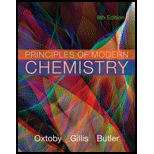
Concept explainers
(a)
Interpretation: The relative molecular mass of
Concept Introduction: The molecular mass of any compound can be calculated by taking sum of atomic masses of all the elements present in it. For example, the molecular mass of AB can be calculated as follows:
Here, A and B are atoms of two different elements.
(b)
Interpretation: The relative molecular mass of
Concept Introduction: The molecular mass of any compound can be calculated by taking sum of atomic masses of all the elements present in it. For example, the molecular mass of AB can be calculated as follows:
Here, A and B are atoms of two different elements.
(c)
Interpretation: The relative molecular mass of OsO4 needs to be determined.
Concept Introduction: The molecular mass of any compound can be calculated by taking sum of atomic masses of all the elements present in it. For example, the molecular mass of AB can be calculated as follows:
Here, A and B are atoms of two different elements.
(d)
Interpretation: The relative molecular mass of H2SO4 needs to be determined.
Concept Introduction: The molecular mass of any compound can be calculated by taking sum of atomic masses of all the elements present in it. For example, the molecular mass of AB can be calculated as follows:
Here, A and B are atoms of two different elements.
(e)
Interpretation: The relative molecular mass of Ca3Al2(SiO4)3needs to be determined.
Concept Introduction: The molecular mass of any compound can be calculated by taking sum of atomic masses of all the elements present in it. For example, the molecular mass of AB can be calculated as follows:
Here, A and B are atoms of two different elements.
Want to see the full answer?
Check out a sample textbook solution
Chapter 1 Solutions
Principles of Modern Chemistry
- Synthesize 1,4-dibromobenzene from acetanilide (N-phenylacetamide) using the necessary organic or inorganic reagents. Draw the structures of the compounds.arrow_forwardIndicate the products obtained by mixing (3-oxo-3-phenylpropyl)triphenylphosphonium bromide with sodium hydride.arrow_forwardWe mix N-ethyl-2-hexanamine with excess methyl iodide and followed by heating with aqueous Ag2O. Indicate the major products obtained.arrow_forward
- Indicate the products obtained by mixing acetophenone with iodine and NaOH.arrow_forwardIndicate the products obtained by mixing 2-Propanone and ethyllithium and performing a subsequent acid hydrolysis.arrow_forwardIndicate the products obtained if (E)-2-butenal and 3-oxo-butanenitrile are mixed with sodium ethoxide in ethanol.arrow_forward
- Question 3 (4 points), Draw a full arrow-pushing mechanism for the following reaction Please draw all structures clearly. Note that this intramolecular cyclization is analogous to the mechanism for halohydrin formation. COH Br + HBr Brarrow_forwardIndicate the products obtained if 2,2-dimethylpropanal and acetaldehyde are mixed with sodium ethoxide in ethanol.arrow_forwardIndicate the products obtained if 2,2-dimethylpropanal and acetaldehyde are reacted with sodium ethoxide in ethanol.arrow_forward
- 2,2-Dimethylpropanal and acetaldehyde are reacted with sodium ethoxide in ethanol. Indicate the products obtained.arrow_forwardAdd conditions above and below the arrow that turn the reactant below into the product below in a single transformationADS fint anditions 百 Abl res condinese NC ง Add on condtions 1.0 B H,N.arrow_forward3. Provide all the steps and reagents for this synthesis. OHarrow_forward
 Chemistry: Principles and ReactionsChemistryISBN:9781305079373Author:William L. Masterton, Cecile N. HurleyPublisher:Cengage Learning
Chemistry: Principles and ReactionsChemistryISBN:9781305079373Author:William L. Masterton, Cecile N. HurleyPublisher:Cengage Learning Chemistry: The Molecular ScienceChemistryISBN:9781285199047Author:John W. Moore, Conrad L. StanitskiPublisher:Cengage Learning
Chemistry: The Molecular ScienceChemistryISBN:9781285199047Author:John W. Moore, Conrad L. StanitskiPublisher:Cengage Learning Chemistry: Principles and PracticeChemistryISBN:9780534420123Author:Daniel L. Reger, Scott R. Goode, David W. Ball, Edward MercerPublisher:Cengage Learning
Chemistry: Principles and PracticeChemistryISBN:9780534420123Author:Daniel L. Reger, Scott R. Goode, David W. Ball, Edward MercerPublisher:Cengage Learning


